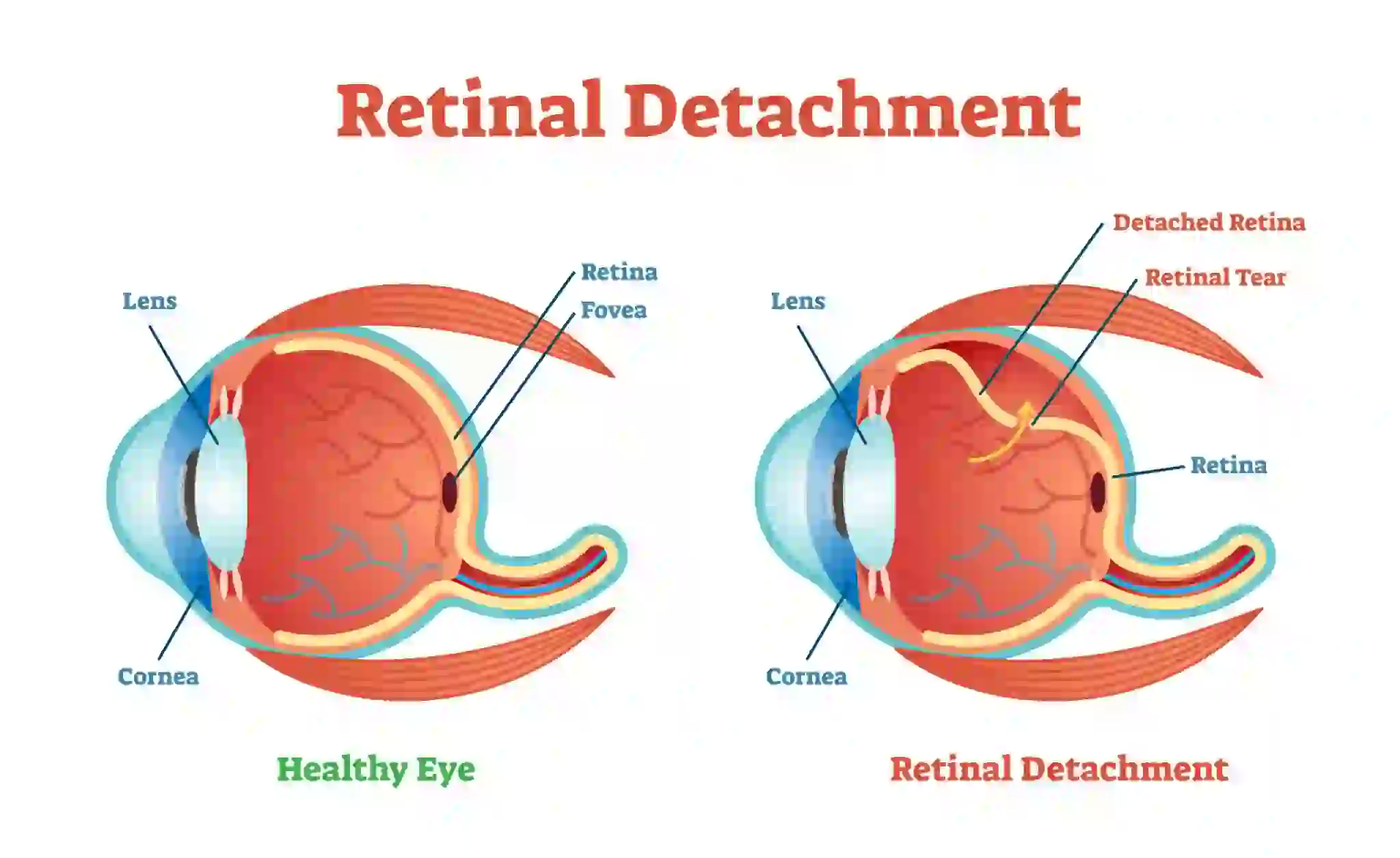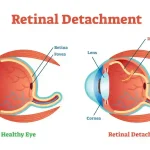Blog Outline:
- Introduction: When Vision Hangs by a Thread
- What Is Retinal Detachment?
- Recognising Retinal Detachment Symptoms
- Common Causes of Retinal Detachment
- Emergency Response: What To Do Right Away
- Effective Retinal Detachment Treatment Options
- Healing After Retinal Detachment Surgery
- Retinal Detachment Prevention: Can It Be Avoided?
- Protecting Your Vision, Preserving Your Life
- FAQs About Retinal Detachment
Your eyes are your window to the world. But what if the very tissue that lets you see begins to peel away from its lifeline? When the retina detaches, it’s not just a minor issue; it’s a vision emergency that can lead to permanent loss of sight if not treated promptly. This guide covers the early warning signs, causes, emergency response, and recovery journey, so you can act confidently.
What Is Retinal Detachment?
Retinal detachment happens when the retina – the light-sensitive layer at the back of the eye – separates from the layer that provides it with oxygen and nutrients. This disconnection can stop the retina from functioning, leading to serious vision impairment.
There are three major types:
- Rhegmatogenous: Caused by a tear or hole that allows fluid to seep under and lift the retina.
- Tractional: When scar tissue pulls the retina away from the back of the eye.
- Exudative: Fluid collects under the retina without a tear, often due to inflammation, injury, or underlying disease.
Recognising Retinal Detachment Symptoms
One of the trickiest parts of retinal detachment is that it’s often painless, but it doesn’t come without warnings. Spotting early retinal detachment symptoms can save your vision:
- Sudden floaters: Small, drifting spots or threads in your vision
- Flashes of light: Often seen on the edges of your visual field
- A dark curtain or shadow creeping across your sight
- Blurred or distorted vision
- Loss of side (peripheral) vision
If you notice any of these retinal detachment symptoms, don’t wait – seek medical help immediately. Every hour counts.
Common Causes of Retinal Detachment
Understanding what leads to detachment is essential for both awareness and prevention. The causes of retinal detachment include:
- Ageing: Most common in people over 50
- Severe myopia (nearsightedness): Thinner retinas are more prone to tearing
- Eye trauma: Injury or blunt force can displace or tear the retina
- Previous eye surgery: Especially cataract operations
- Family history: Genetics may play a contributing role
- Other eye conditions: Like lattice degeneration or diabetic retinopathy
While you can’t control all the causes of retinal detachment, staying informed can help reduce your risk or catch issues before they escalate.
Emergency Response: What to Do If You Suspect Retinal Detachment
Think you’re experiencing a detachment? Here’s what to do:
- Contact an ophthalmologist or eye hospital immediately
- Do not rub your eyes – it can worsen the situation
- Keep your head elevated, especially if advised by a doctor
- Avoid self-treatment – this is not something eye drops can fix
Remember: Retinal detachment is not a wait-and-see condition. Fast action can make all the difference.
Effective Retinal Detachment Treatment Options
When it comes to retinal detachment treatment, surgery is typically the only way forward. Treatment depends on the type and extent of the detachment. Common procedures include:
- Laser Photocoagulation: A precise laser seals tears
- Cryopexy: Freezing the area to scar it and secure the retina
- Pneumatic Retinopexy: A gas bubble pushes the retina back before sealing
- Scleral Buckling: A silicone band gently presses the eye to support the retina
- Vitrectomy: The vitreous gel is removed and replaced with a bubble or oil to reattach the retina
Each retinal detachment treatment plan is personalised, depending on your condition, lifestyle, and urgency.
Healing After Retinal Detachment Surgery
Recovering from retinal detachment surgery can be demanding, but it’s crucial to follow the aftercare plan meticulously:
- Use prescribed medications, usually antibiotic and anti-inflammatory eye drops
- Limit physical activity – no bending, lifting, or straining
- Follow positioning instructions, especially for gas bubble procedures
- Avoid flying if a gas bubble is in your eye
- Attend follow-up visits to ensure proper healing
Some people notice improved vision within weeks, while others take months to regain clarity. Either way, patience and discipline are key.
Retinal Detachment Prevention: Can It Be Avoided?
Although it isn’t always preventable, you can significantly reduce your risk with some proactive steps. Here’s how retinal detachment prevention works:
- Get regular eye exams, especially if you’re nearsighted or over 40
- Protect your eyes during contact sports or high-risk work
- Control chronic conditions like high blood pressure and diabetes
- Stay alert to retinal detachment symptoms and seek care immediately
- If you’ve had eye surgery, follow your post-op instructions carefully
Retinal detachment prevention is about vigilance and lifestyle. The earlier an issue is caught, the better your visual outcome.
Protecting Your Vision, Preserving Your Life
Yes, retinal detachment can be frightening, but it doesn’t have to mean blindness. With quick diagnosis and the right retinal detachment treatment, most people maintain functional vision. If you ever see flashes, floaters, or shadows in your field of vision, don’t ignore them. Act fast. Your future self will thank you.
FAQs About Retinal Detachment
Can one get a detached retina again after treatment?
Yes, it’s possible, especially if you’re at risk (e.g., nearsighted, previous detachment).
Is surgery always necessary for retinal detachment?
Yes, in most cases, surgery is needed to reattach the retina.
Are there any complications or risks associated with retinal detachment surgery?
Yes, risks include infection, bleeding, cataracts, and in rare cases, vision loss.
What is the long-term outlook for someone who has experienced retinal detachment?
With timely treatment, many regain useful vision, but long-term follow-up is crucial.
Is retinal detachment hereditary?
It can have genetic factors, but it’s mostly due to aging or trauma rather than direct heredity.
Can retinal detachment happen again after surgery?
Yes, especially if you’re highly nearsighted or have had a previous detachment. Regular checkups are crucial.
Is surgery always necessary for retinal detachment?
In nearly all cases, yes. Delaying surgery could result in irreversible vision loss.
Are there any complications after surgery?
Risks include infection, cataracts, bleeding, or scar tissue. Your surgeon will guide you on what to expect.
What’s the long-term outlook?
Many regain functional vision, especially with early treatment. Some may experience minor vision distortions.
Is retinal detachment hereditary?
Not always, but a family history increases your risk. Combine that with myopia or trauma, and your risk rises.





